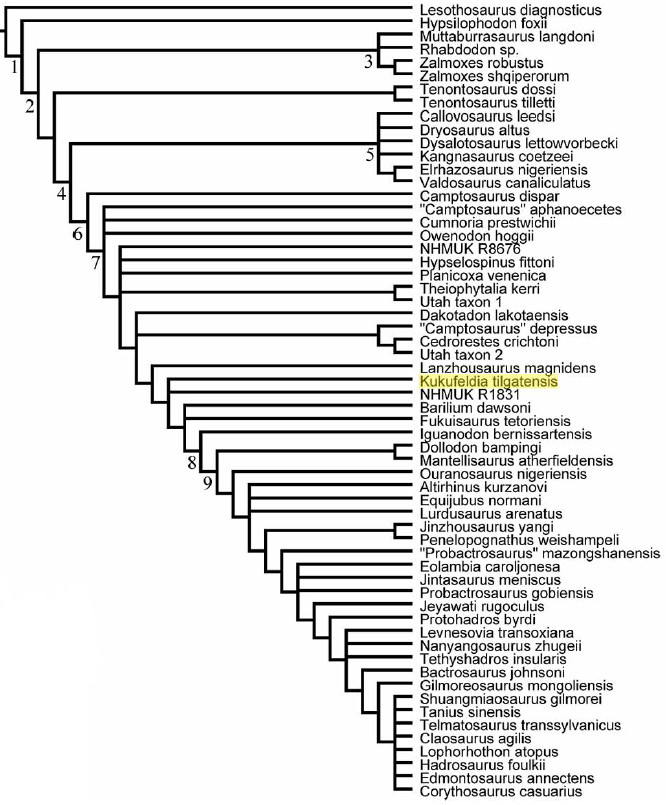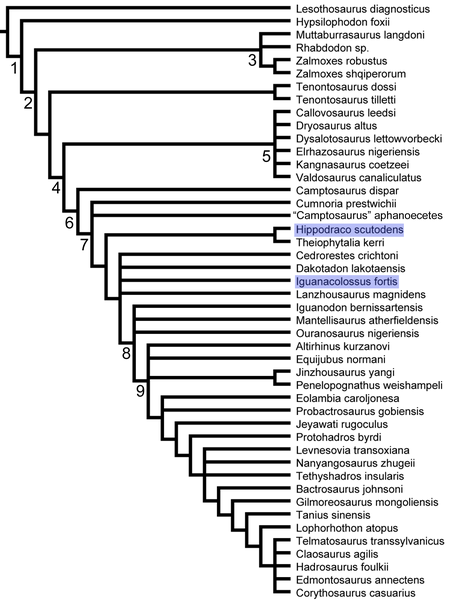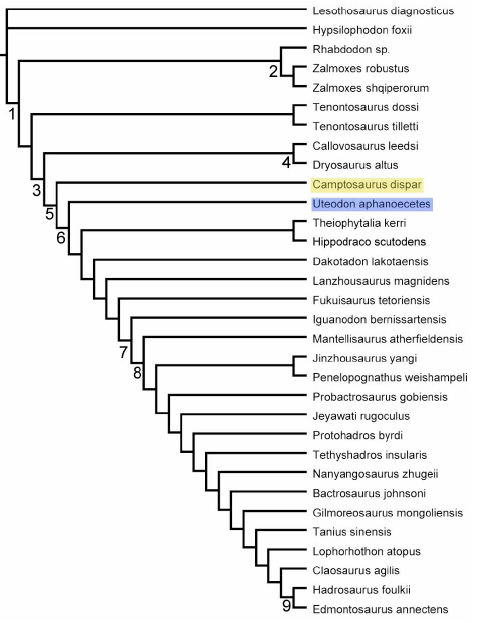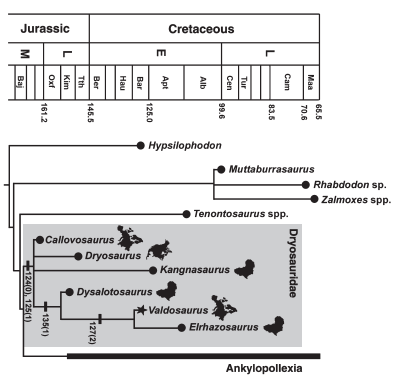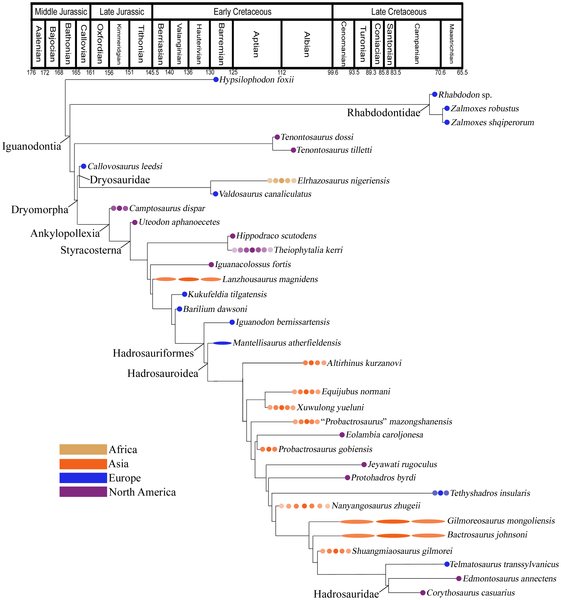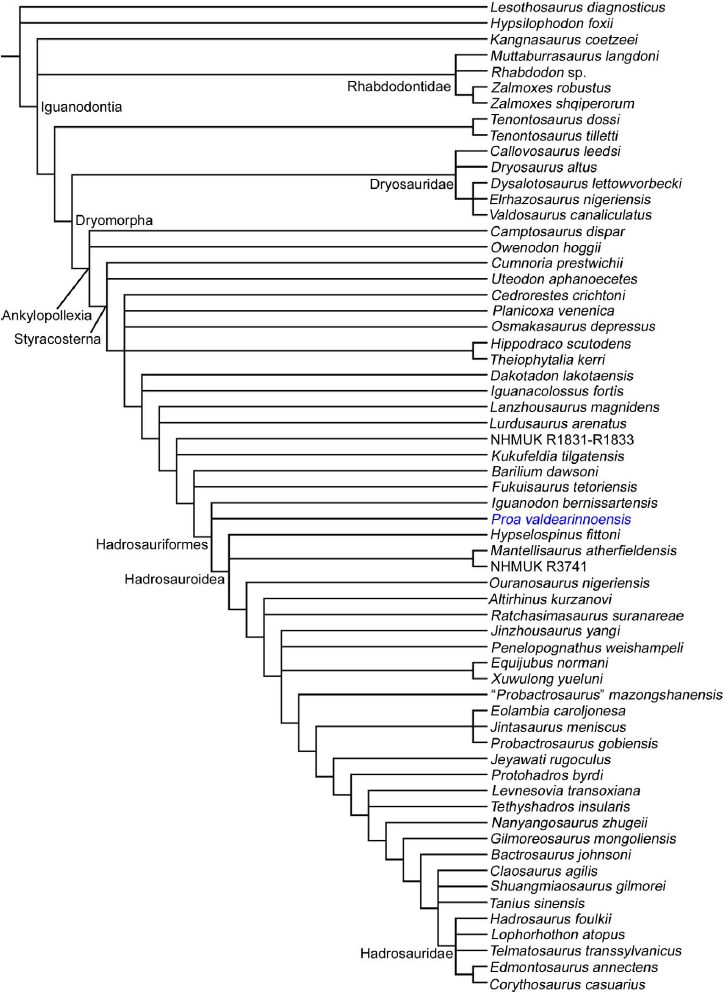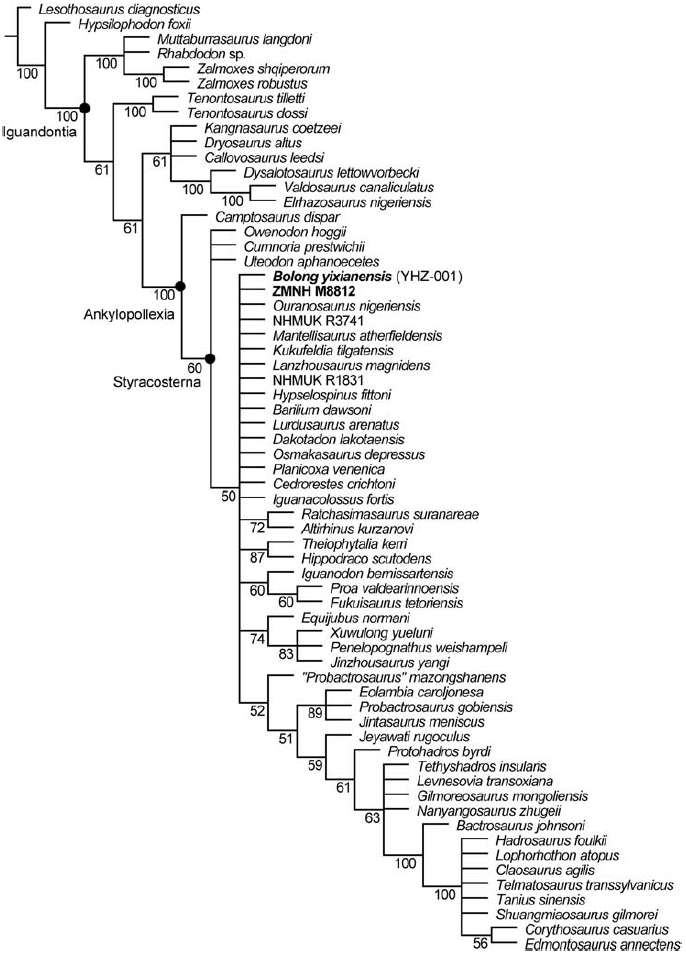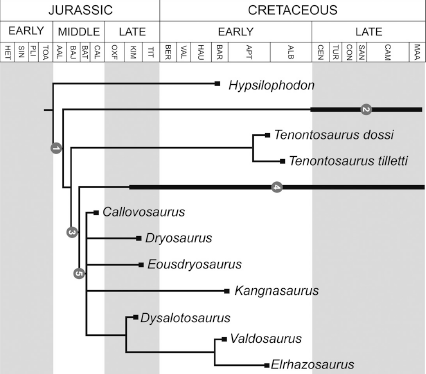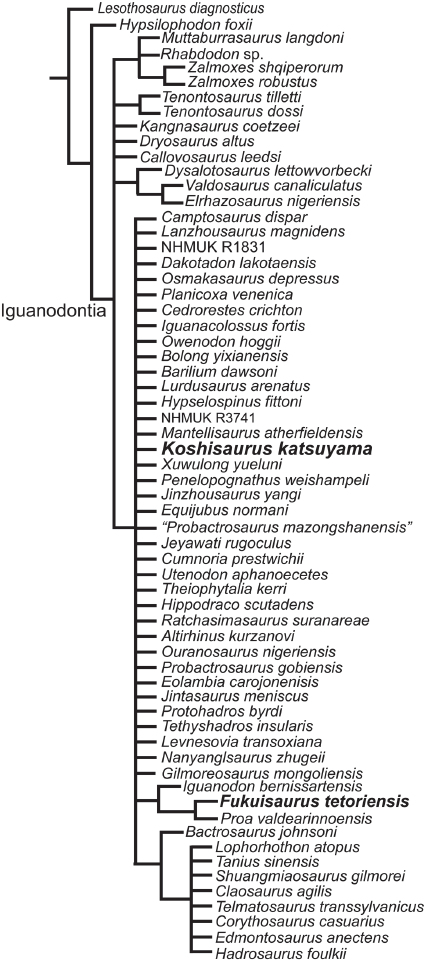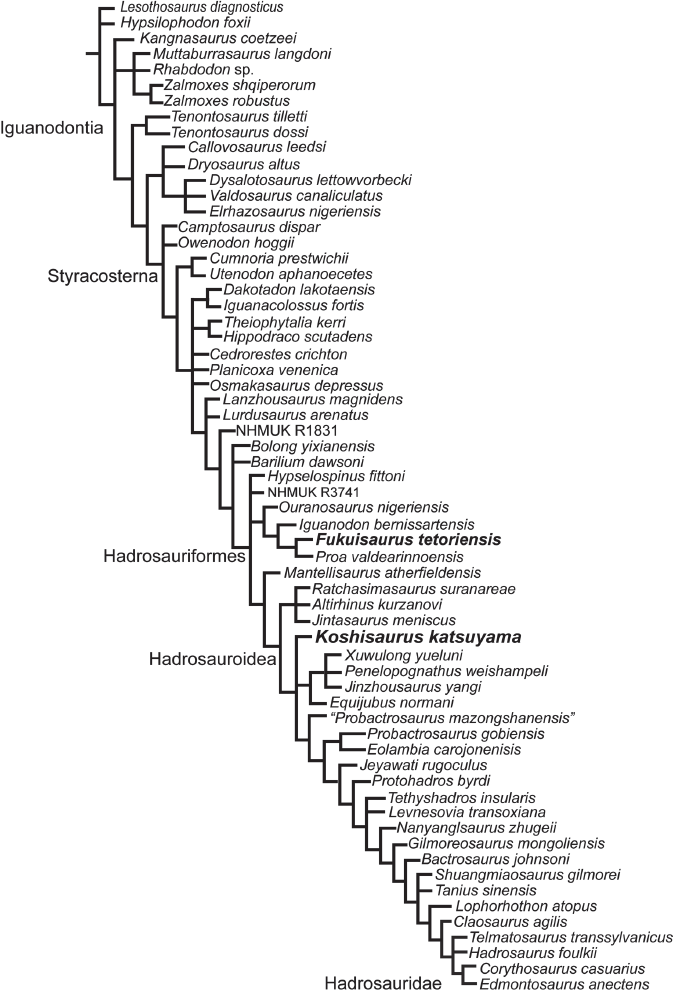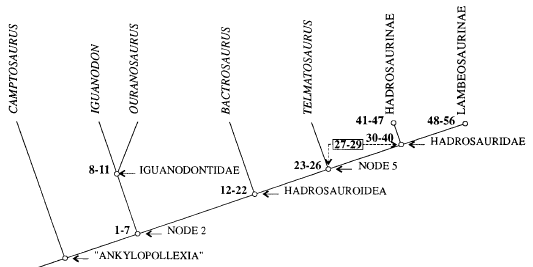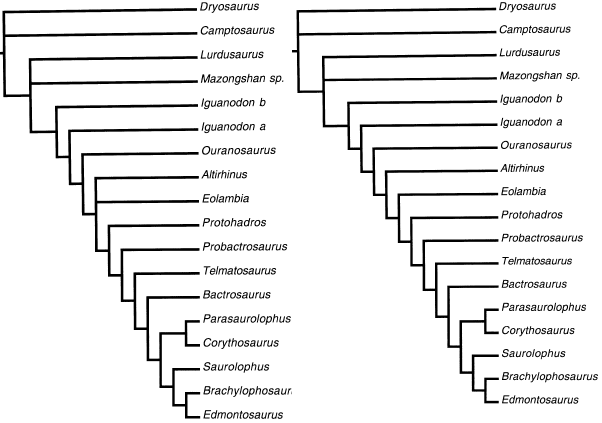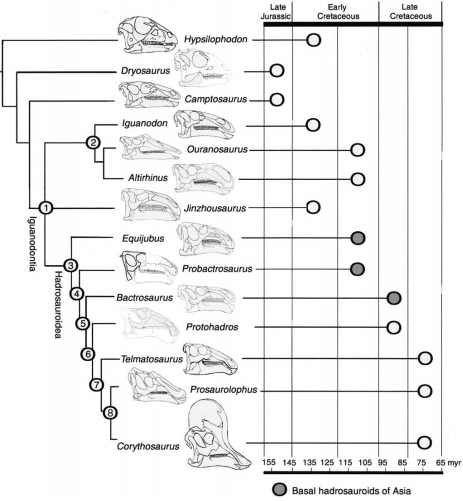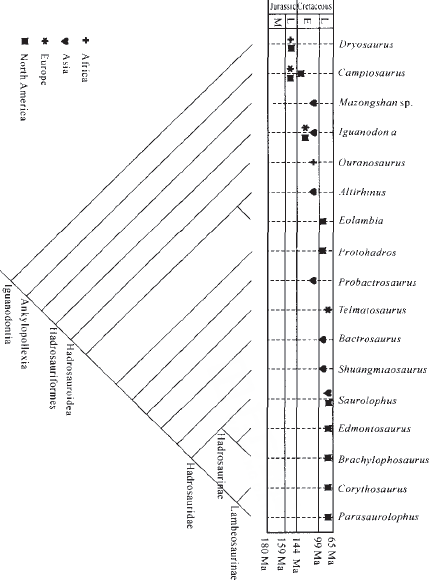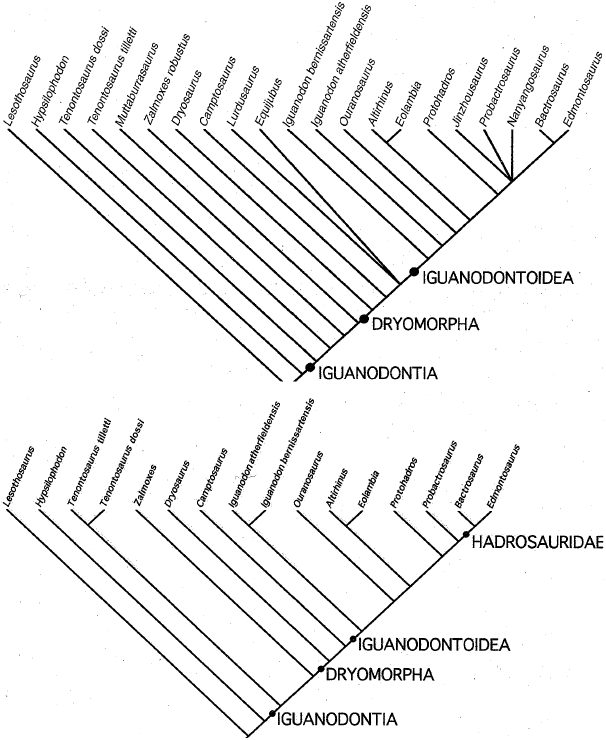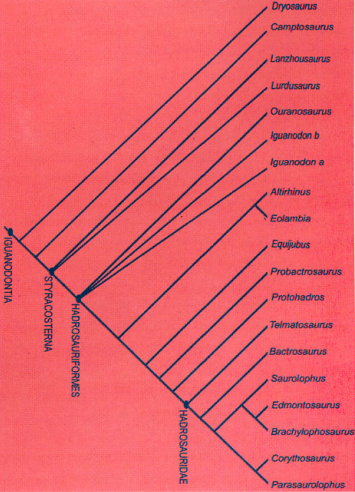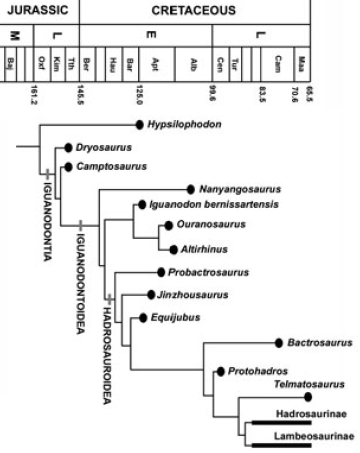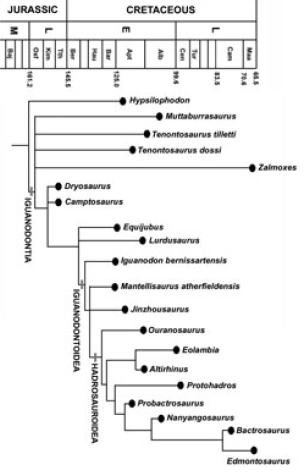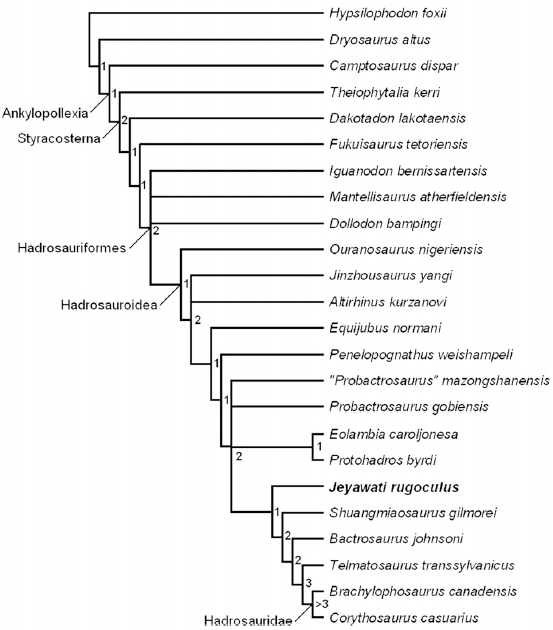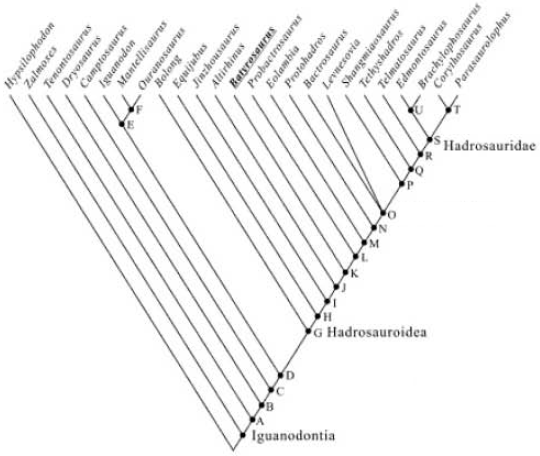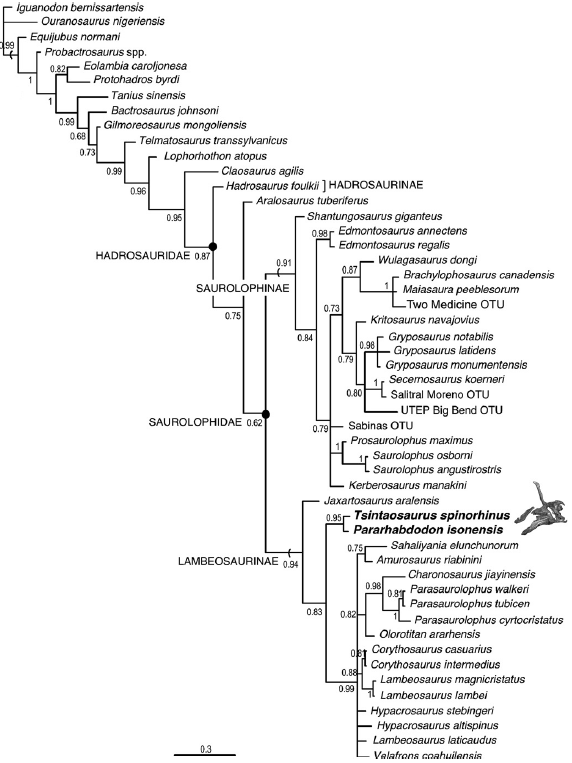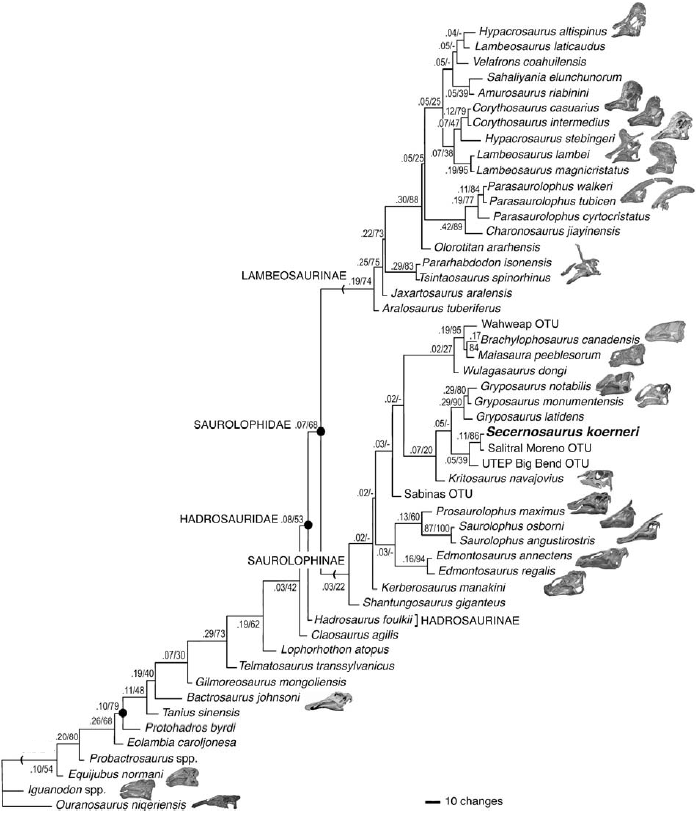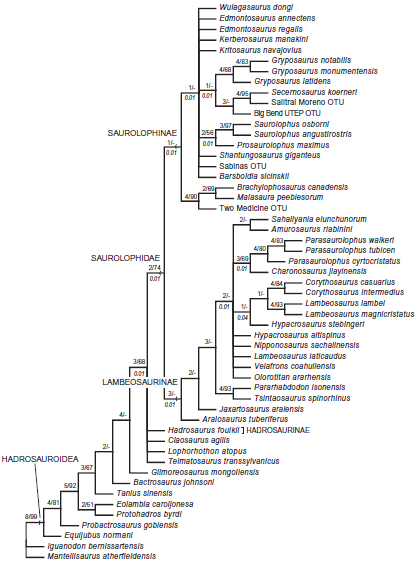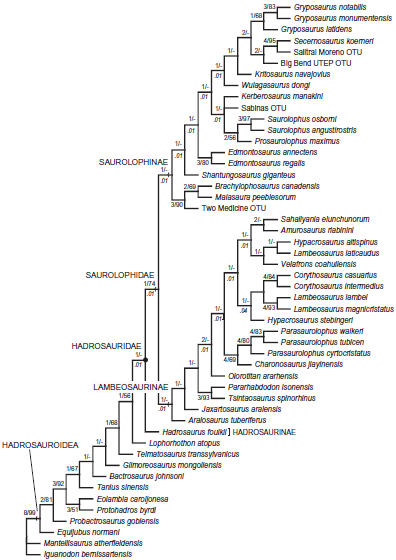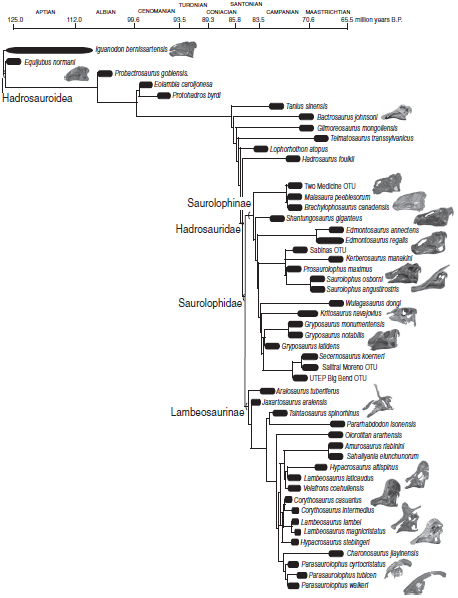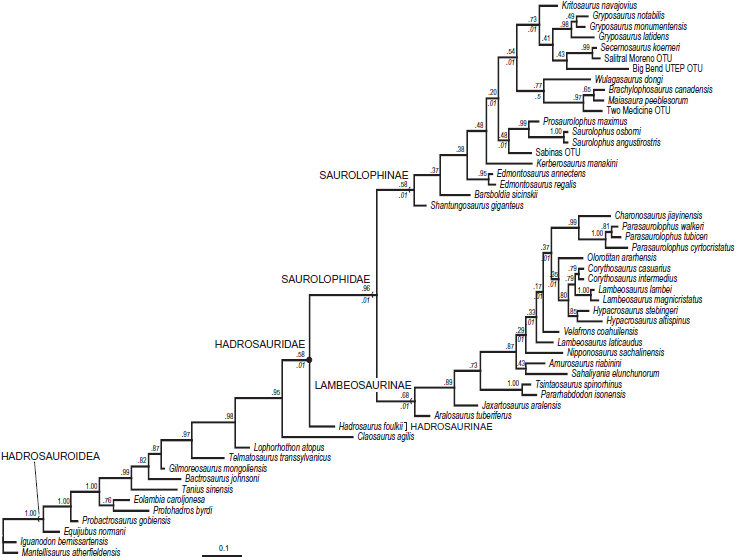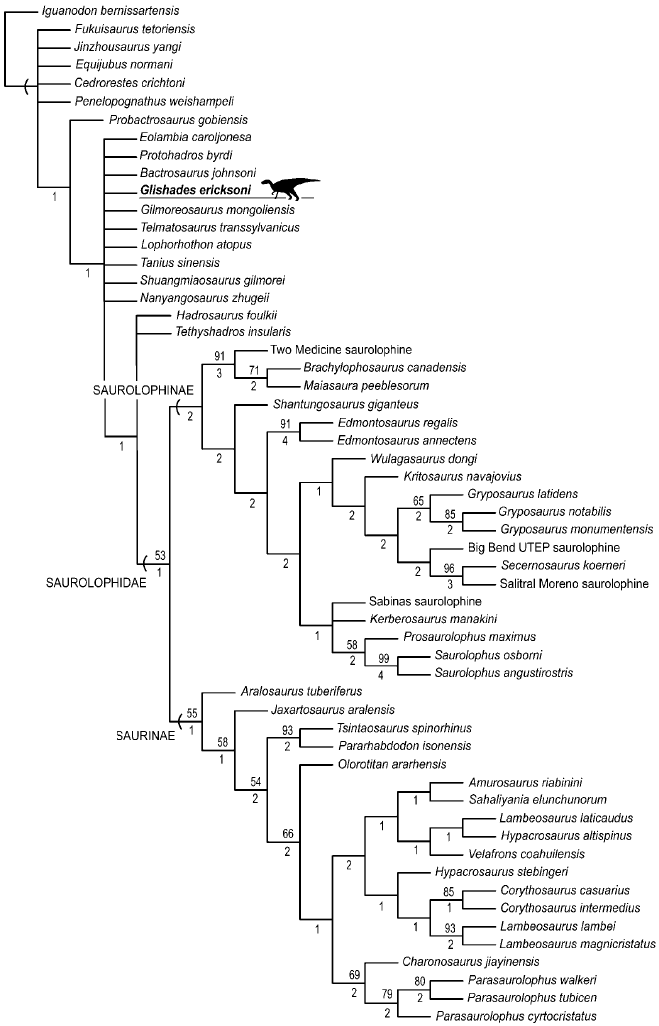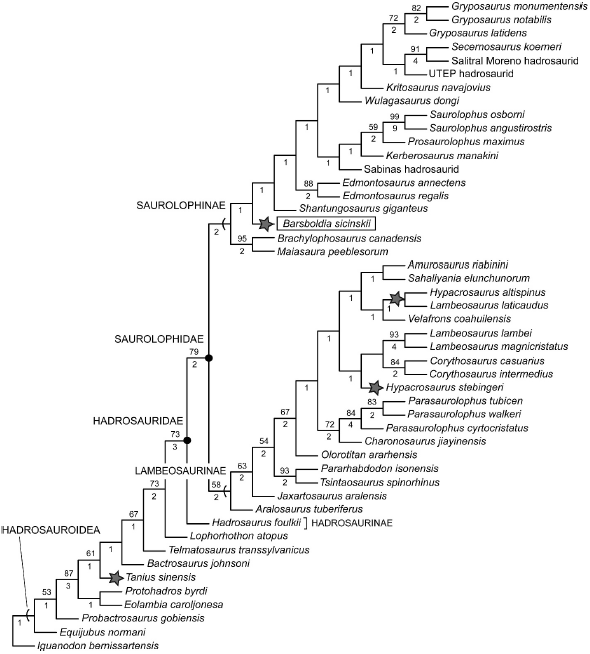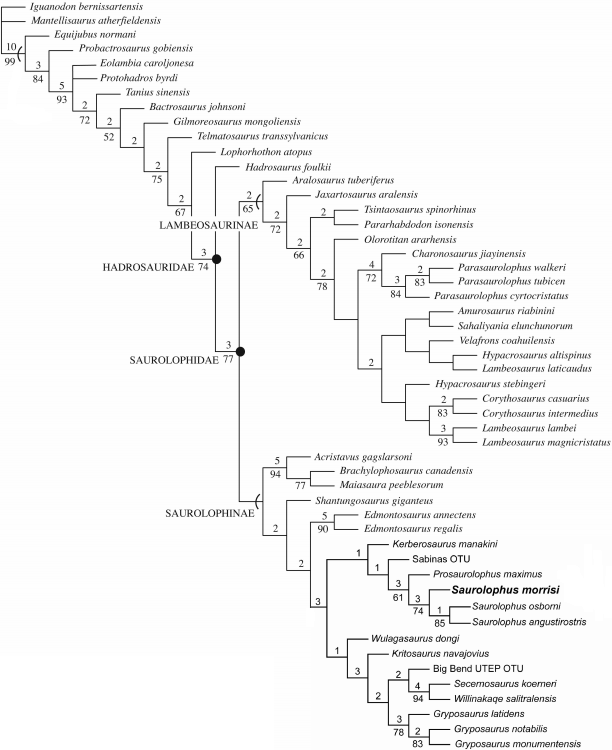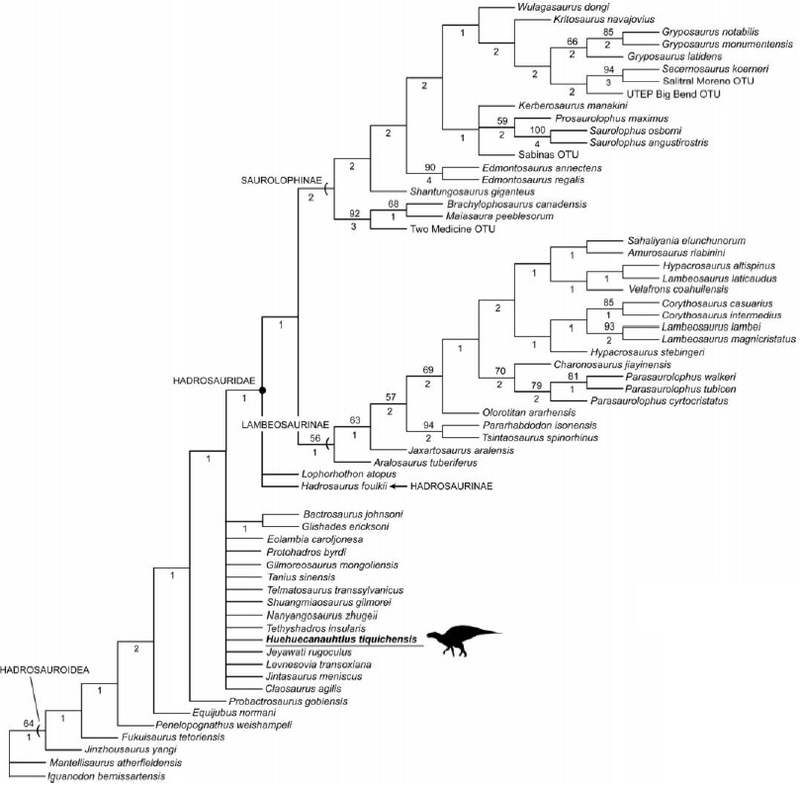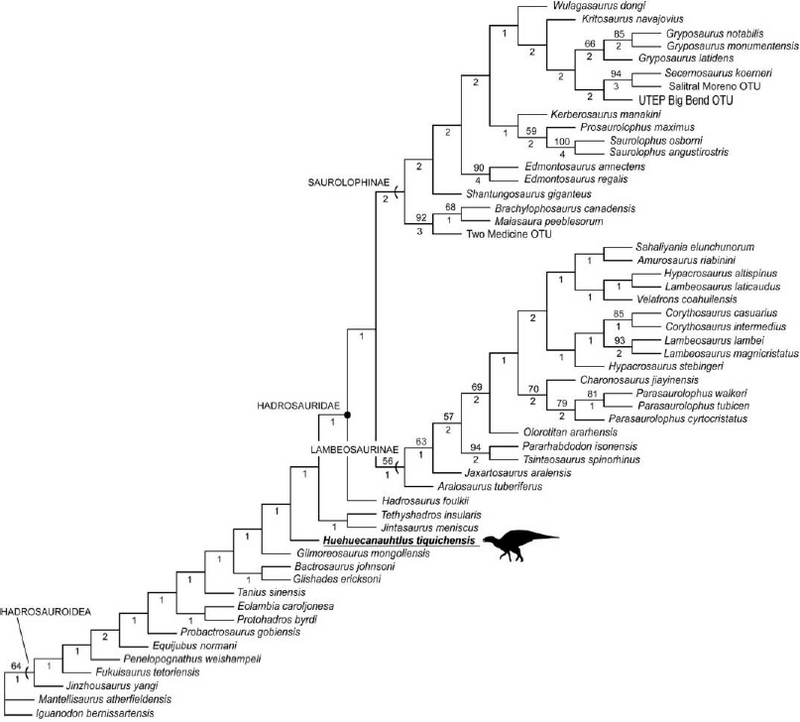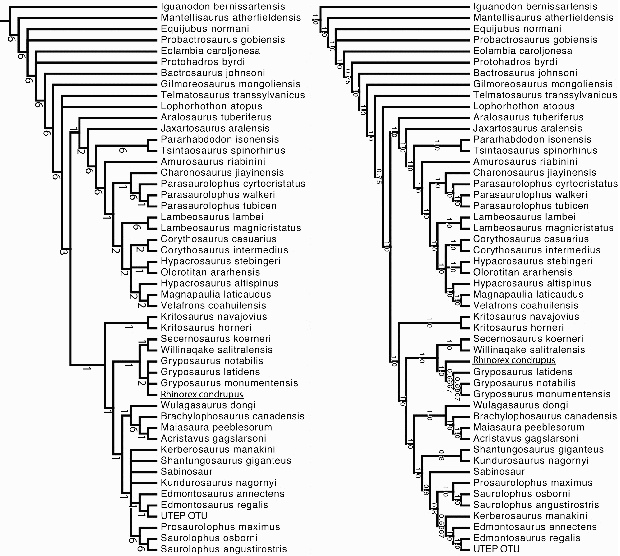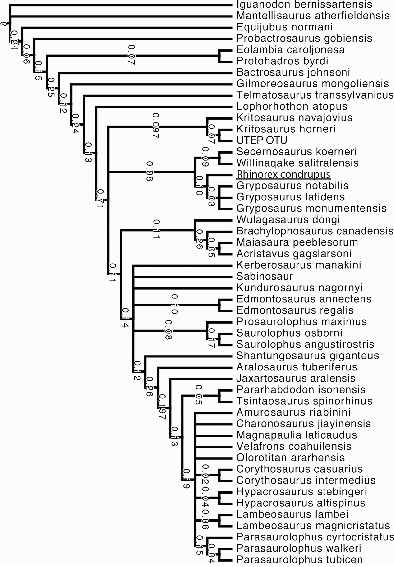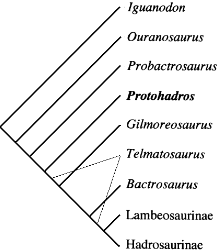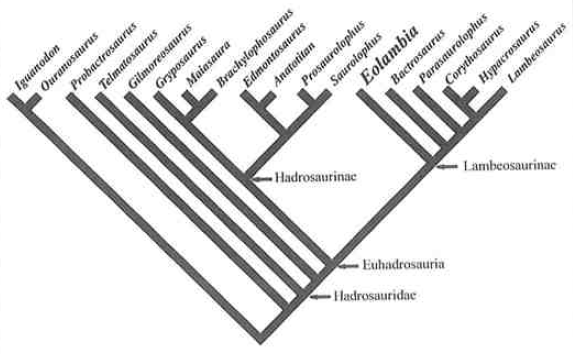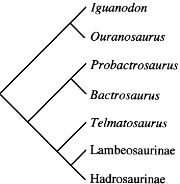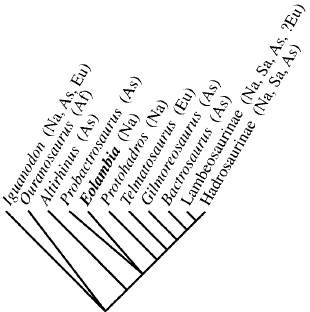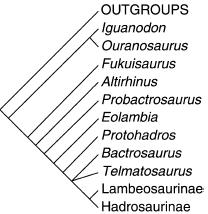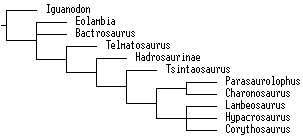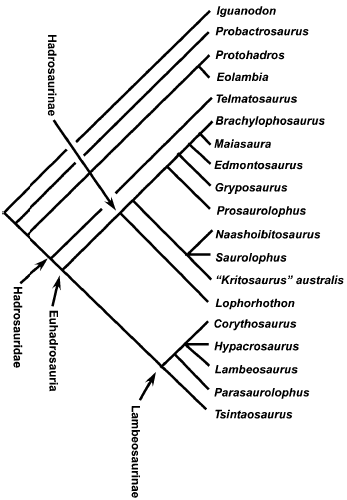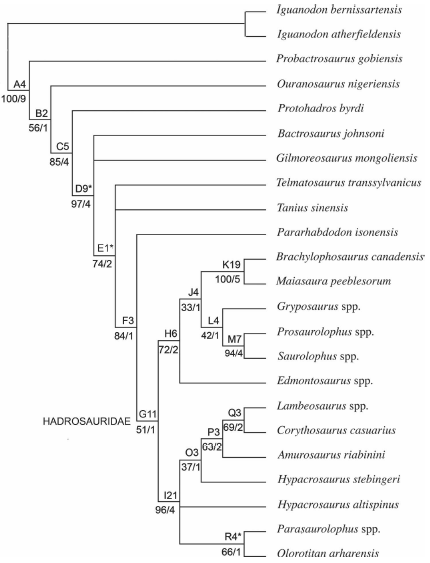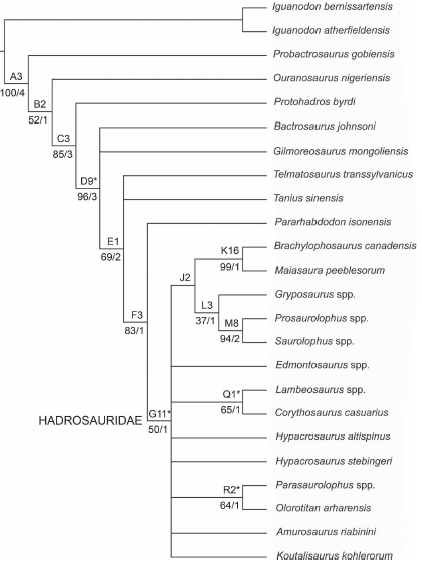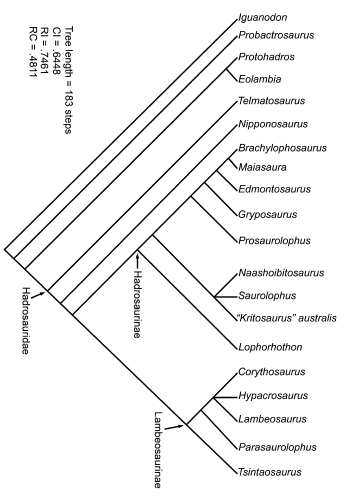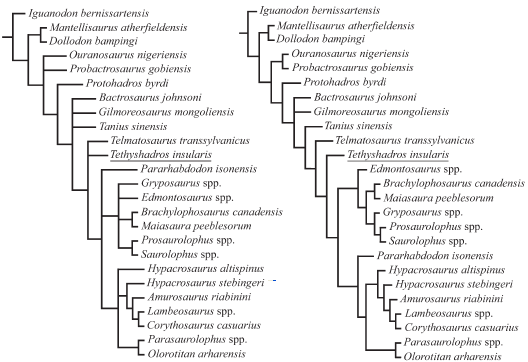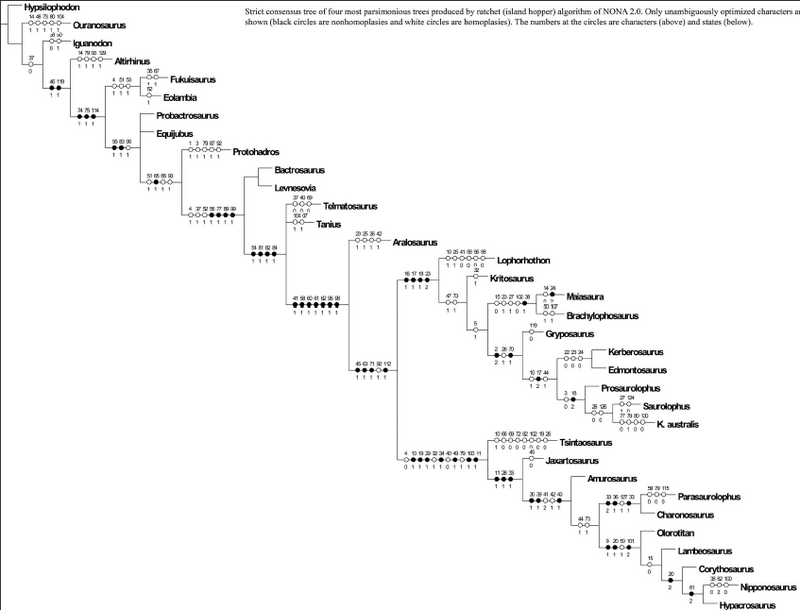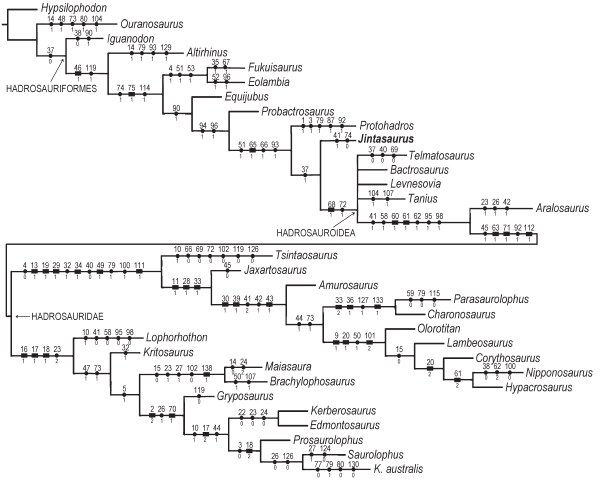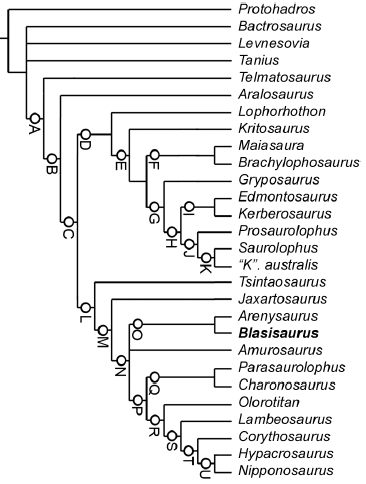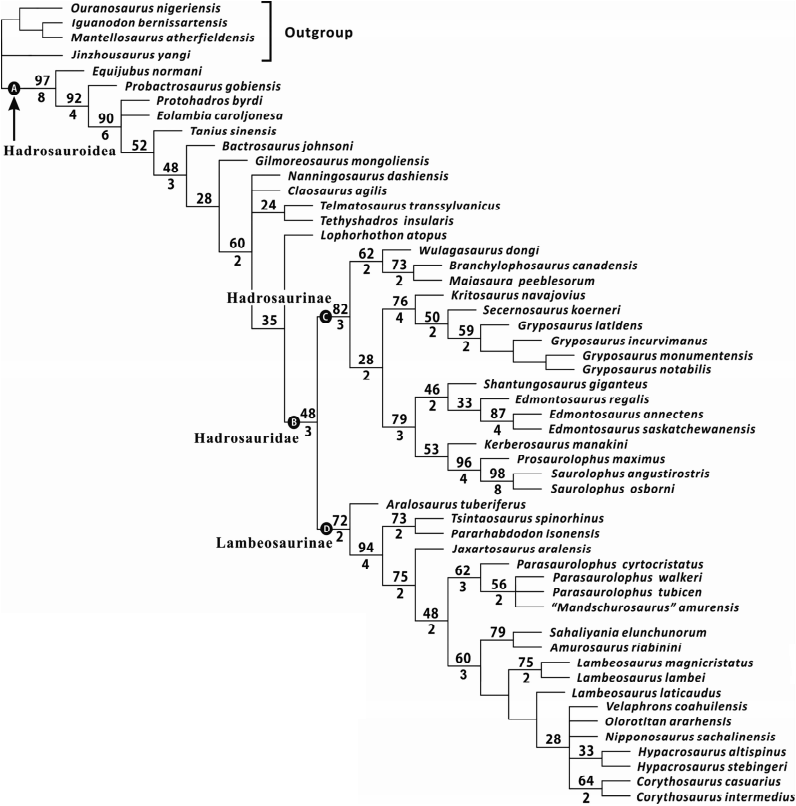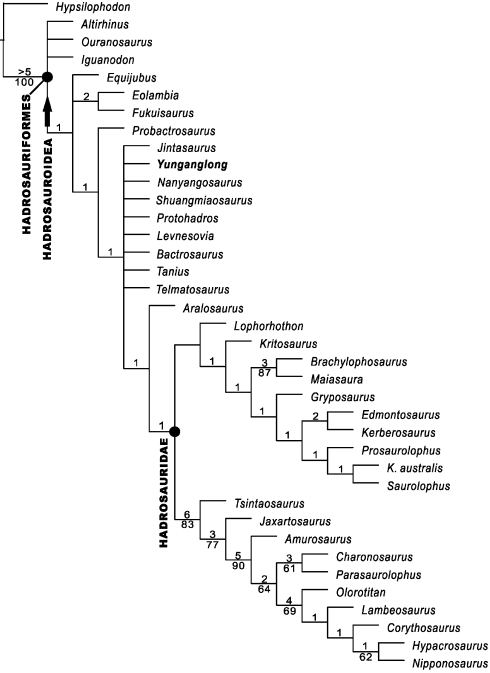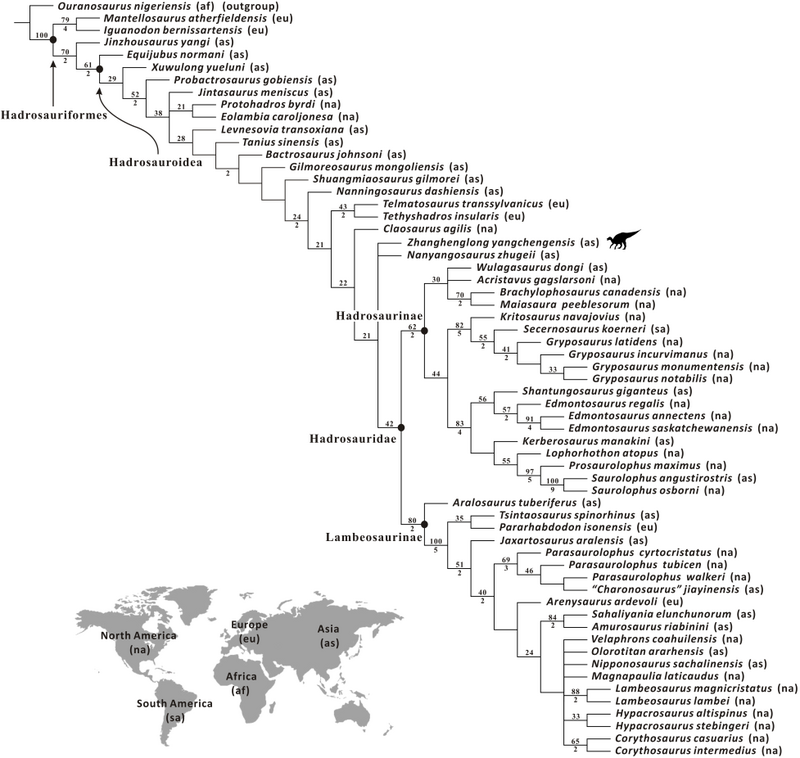Kategoria:Iguanodontia
| Opracowanie: |
| Maciej Ziegler |
| Ornithopoda (ornitopody) | |
|---|---|
| Czas występowania |
162 - 66 Ma |
| Dieta | roślinożerne |
| Rozmiary | do 15 m długości |
| Występowanie | cały świat |
| Systematyka | Dinosauria
|
Artykuł przedstawia nomenklaturę i filogenezę głównie bazalnych Iguanodontia (tj. nie należących do Hadrosauridae) ale także Hadrosauridae. Jest to zalążek przyszłego artykułu (jeśli możesz - napisz go!).
Nomenklatura
- Iguanodontia (Dollo, 1888)
- >Parasaurolophus walkeri ~ Hypsilophodon foxii v Thescelosaurus neglectus (Sereno, 2005)
- Pierwszą opublikowaną definicją była Sereno z 1998 r. (<Parasaurolophus ~ Hypsilophodon), oparta na hipotezie monofiletyczności bazalnych (nieiguanodontowych) ornitopodów. Późniejsze badania wskazały jednak na parafiletyczność tej grupy i taki jest obecny konsensus. Norman i in. (2004) zaproponowali wyłączenie Thescelosaurus z Iguanodontia (gdyż ich zdaniem to on jest najbardziej zaawansowany z bazalnych ornitopodów). Definicja Sereno z 2005 r. łączy obie definicje, wyłączając zarówno Hypsilophodon, jak i Thescelosaurus, dając przez to zasięg nazwy kladu bardziej zgodny z tradycyjnym nazewnictwem - przez większą niezależność od przyjętej hipotezy filogenetycznej.
- Euiguanodontia (Coria i Salgado, 1996)
- <Gasparinisaura cincosaltensis & Dryosaurus altus & Camptosaurus dispar Parasaurolophus walkeri (zmodyfikowano z Coria i Salgado, 1996)
- Wg niektórych analiz (Weishampel i in. 2003) to klad o szerszym zasięgu od początkowo zakładanego (szerszy niż Iguanodontia).
- Elasmaria (Calvo, Porfiri i Novas, 2007)
- <Talenkauen santacrucensis & Macrogryphosaurus gondwanicus (Calvo, Porfiri i Novas, 2007)
- Wg większości analiz to klad należący do Euiguanodontia; wyjątek to Godefroit i in. (2014).
- Dryomorpha (Sereno, 1986)
- <Dryosaurus altus & Parasaurolophus walkeri (Sereno, 2005)
- Dryosauridae (Milner i Norman, 1984)
- >Dryosaurus altus ~ Parasaurolophus walkeri (Sereno, 2005; zmodyfikowano z Sereno, 1998)
- Ankylopollexia (Sereno, 1986)
- <Camptosaurus dispar & Parasaurolophus walkeri (Sereno, 2005; zmodyfikowano z Sereno, 1998)
- Camptosauridae (Marsh, 1885)
- >Camptosaurus dispar ~ Parasaurolophus walkeri (Sereno, 2005; zmodyfikowano z Sereno, 1998)
- Styracosterna (Sereno, 1986)
- >Parasaurolophus walkeri ~ Camptosaurus dispar (Sereno, 2005; zmodyfikowano z Sereno, 1998)
- Czasem używa się później zdefiniowanej (2002) nazwy Iguanodontoidea (Cope, 1869 sensu Hay, 1902): Iguanodon bernissartensis & Edmontosaurus regalis ~ Camptosaurus dispar (zmodyfikowano z Norman, 2002)
- Hadrosauriformes (Sereno, 1997)
- <Iguanodon bernissartensis & Parasaurolophus walkeri (Sereno, 2005; zmodyfikowano z Sereno, 1998)
- Neoiguanodontia (Norman, 2014)
- <Hypselospinus fittoni & Parasaurolophus walkeri (Norman, 2014)
- Wg analizy McDonalda i in. (2012) jest to zaawansowany klad o zasięgu teoretycznie węższym niż Hadrosauroidea, natomiast wg analizy analizy Normana (2014) zasięg kladu jest szerszy niż Hadrosauriformes.
- Iguanodontidae (Cope, 1869)
- >Iguanodon bernissartensis ~ Parasaurolophus walkeri (Sereno, 2005; zmodyfikowano z Sereno, 1998)
- Hadrosauroidea (Cope, 1869 sensu Huene, 1952)
- >Parasaurolophus walkeri ~ Iguanodon bernissartensis (Sereno, 2005; zmodyfikowano z Sereno, 1998)
- Czasem używa się nazwy Hadrosauroidea w węższym znaczeniu. Godefroit i in. (1998, s. 8) uznali Hadrosauroidea za klad zawierający Bactrosaurus, Telmatosaurus i Hadrosauridae (Hadrosauridae + Lambeosaurinae), trudno jednak stwierdzić, czy jest to definicja filogenetyczna.
- Hadrosauromorpha (Norman, 2014)
- > Parasaurolophus walkeri ~ Probactrosaurus gobiensis (Norman, 2014)
- Hadrosauridae (Cope, 1869)
- <Lambeosaurus lambei & Hadrosaurus foulkii (zmodyfikowano z Forster, 1997)
- Klad Hadrosauridae był definiowany rozmaicie (np. Horner i in., 2004 dodają do definicji dość bazalnego Telmatosaurus). Klad Hadrosauridae został po raz pierwszy zdefiniowany przez Forster (1997) jako <Lambeosaurinae & Hadrosaurinae. Hadrosaurus foulkii, który powinien należeć do Hadrosauridae, ma niepewną pozycję filogenetyczną, był rzadko umieszczany w analizach a jego pozycję w ramach obszernego kladu siostrzanego do Lambeosaurinae (nazywanego przeważnie Hadrosaurinae) przyjmowano a priori. Nowe, obszerne badania (Prieto-Marqueza (2010) wskazują, że Hadrosaurus jest bardziej bazalny - jest jedynym członkiem Hadrosaurinae.
- Czasem używa się później zdefiniowanej (2002) nazwy Iguanodontoidea (Cope, 1869 sensu Hay, 1902): Iguanodon bernissartensis & Edmontosaurus regalis ~ Camptosaurus dispar (zmodyfikowano z Norman, 2002)
Kladogramy
Bazalne Iguanodontia
Zob. Ornithopoda#Kladogramy
McDonald i in. 2011 i modyfikacje
Obszerne analizy filogenetyczne oparte na matrycy opublikowanej po raz pierwszy w pracy McDonalda i in. (2011A).
McDonald i in. 2010A
Kladogram z McDonald i in. 2010A.
McDonald i in. 2011B
Kladogramy z McDonald i in. 2011B = McDonald 2011B (na podstawie McDonald i in. 2011A z Dollodon i Mantellisaurus jako jednym taksonem i usunięciem 13 taksonów). U góry ścisły konsensus, na dole konsensus po usunięciu 13 taksonów.
Barrett i in. 2011
Kladogram z Barrett i in. 2011 - uproszczony (na podstawie McDonald i in. 2011A ze zmianami u Valdosaurus, 6 nowymi cechami i innymi zmianami).
McDonald 2012
Skalibrowany stratygranicznie kladogram z McDonald, 2012 - ścisły konsensus z usuniętymi problematycznymi taksonami (na podstawie McDonald i in. 2010B i McDonald, 2011 z dodaniem Delapparentia, Ratchasimasaurus, Xuwulong i Glishades, wydzieleniem NHMUK R3741, z zmianą jednej cechy za Barrett i in. 2011, dodaniem 4 cech, dodatkowymi informacjami o Valdosaurus, Barilium, Jinzhousaurus, Equijubus i Gilmoreosaurus i rewizją Iguanacolossus.
McDonald i in. 2012
Kladogram z McDonald, 2012 - Adams consensus z usuniętymi problematycznymi taksonami (na podstawie McDonald, 2012 z dodaniem Proa).
Zheng i in. 2014
Kladogram ze Zheng i in., 2014 - 50% majority rule (na podstawie McDonald, 2012, z dodanymi Bolong, ZMNH M8812 - młodym Bolong i Proa).
Escaso i in. 2014
Skalibrowany stratygranicznie kladogram z Escaso i in. 2014, uproszczony (na podstawie Barrett i in. 2011 z dodanym Eousdryosaurus). Numery oznaczają: Iguanodontia (1), Rhabdodontidae (2), Dryomorpha (3), Ankylopollexia (4), Dryosauridae (5).
Shibata i Azuma 2015
Kladogramy z Shibata i Azuma, 2015 - u góry ścisły konsensus, na dole konsensus Adamsa (na postawie McDonald, 2012, z dodanymi Koshisaurus, Proa, Bolong - z wyłączeniem cech zakodowanych z młodego okazu oraz z modfikacją Fukuisaurus).
Inne
Godefroit i in. 1998
Kladogram z Godefroit i in., 1998
Norman 1998
Kladogram z Norman, 1998 (brak analizy numerycznej)
Norman 2002
Kladogram z Norman, 2002. Na lewo ścisły konsensus, na prawo konsnesus po wyważeniu cech.
You i in. 2003A
Kladogram z You i in., 2003A.
You i in. 2003B
Kladogram z You i in., 2003B (na podstawie Norman, 2003 z dadanym Shuangmiaosaurus i usuniętym Iguanodon b i Lurdusaurus).
Norman, 2004
Kladogram z Norman, 2004. U góry ścisły konsensus, na dole po usunięciu 5 taksonów.
You i in. 2005
Kladogram z You i in., 2005 (na podstawie Norman, 2002 z dodatkowymi taksonami i cechami).
Wang i in. 2010 - I
Kladogram z Wang i in., 2010 - I (na podstawie You i in., 2003 z rewizją Jinzhousaurus).
Wang i in. 2010 - II
Kladogram z Wang i in., 2010 - II (na podstawie Norman, 2004 z rewizją Jinzhousaurus).
McDonald i in. 2010C
Kladogram z McDonald i in. 2010C.
Wu i Godefroit 2012/Godefroit i in. 2012
Kladogram z Wu i Godefroit 2012 (=Godefroit i in. 2012).
Norman 2014
Skaligrowany stratygraficznie kladogram z Norman 2014.
Hadrosauroidea
Zob. też powyżej
Prieto-Marquez 2010 i modyfikacje
Obszerne analizy skupione na hadrozaurydach, obejmujące też zaawansowane iguanodonty (Hadrosauroidea), których pierwowzorem jest analiza z rozprawy doktorskiej Prieo-Marqueza (2008).
Prieo-Marquez i Wagner 2009
Prieo-Marquez i Wagner 2009 - analiza Bayesowska.
Prieto-Marquez i Salinas 2010
Kladogram z Prieto-Marquez i Salinas, 2010.
Prieto-Marquez, 2010A
Kladogramy z Prieto-Marquez 2010A: od góry: (1) ścisły konsensus, (2) konsensus po usunięciu Claosaurus, Barsboldia i Nipponosaurus, (3) ten sam skalibrowany stratygraficznie, (4) analiza Bayesowska przy równym temcie zmian cech, (5) analiza Bayesowska przy zmiennym tempie zmian cech.
Prieto-Marquez 2010B
Kladogramy z Prieto-Marquez 2010B (na podstawie Prieto-Marquez 2010A z dodanym Glishades). U góry ścisły konsensus, na dole konsensus po usunięciu niektórych taksonów.
Prieto-Márquez 2011
Kladogram z Prieto-Márquez, 2011 (na podstawie Prieto-Marquez 2010A)
Prieto-Márquez i Wagner 2012
Kladogram z Prieto-Márquez i Wagner, 2012 (na podstawie Prieto-Márquez, 2010A z dodanymi Saurolophus morrisi i trzema nowymi cechami).
Ramírez-Velasco i in. 2012
Kladogramy z Ramírez-Velasco i in., 2012: od góry: (1) ścisły konsensus, (2) konsensus po usunięciu problematycznych taksonów (na podstawie Prieto-Márquez, 2010A z dodaniem nowych taksonów i 1 cechy za Prieto-Márquez i Norell, 2010).
Gates i Scheetz 2014
Kladogramy z Gates i Scheetz, 2014: na górze po lewej ścisły konsnesus, na prawo 50 majority rule, na dole analiza Bayesowska (na podstawie Prieto-Márquez, 2010A z dodanym [[Rhinorex]). "Sabinosaur" zapewne jest pomyłką pisarską (=Sabinas OTU sensu Prieto-Márquez, 2010A).
Inne
Horner 1992
Kladogram z Horner, 1992 (brak analizy numerycznej)
Head 1998
Kladogram z Head, 1998/
Kirkland 1998
Kladogram z Kirkland, 1998
Casanovas i in. 1999
Kladogram z Casanovas i in., 1999
Head 2001
Head, 2001 (na podstawie Head, 1998 z nowymi taksonami i 7 nowymi cechami).
Kobayashi i Azuma 2003
Kladogram z Kobayashi i Azuma, 2003
Godefroit i in. 2001
Kladogram z Godefroit i in., 2001.
Plik .tnt pobrany z Lloyd, online analizowany w TNT 1.1 (Goloboff i in., 2008). Space for 10000 trees in memory, New Technology Search, ‘Driven search’ stabilizing consensus twice with a factor of 75 using Sectorial Search, pozostałe ustawienia domyślne. Best score: 38. 3 trees retained
Horner i in. 2004
Kladogram z Horner i in., 2004
Prieto-Marquez i in. 2006
Kladogramy z z Prieto-Marquez i in., 2006. U bez Koutalisaurus, na dole z.
Mo i in. 2007
Kladogram z Mo i in., 2007 (na podstawie Horner i in., 2004 z dodanym Nanningosaurus).
Cuthbertson i Holmes 2010
Kladogram z Cuthbertson i Holmes, 2010 (na podstawie Horner i in., 2004 z dodanymi 4 cechami i innymi zmianami).
Dalla Vecchia 2009
Kladogramy z Dalla Vecchia, 2009 (na podstawie Prieto-Marquez i in., 2006A z dodanym Tethyshadros, 7 nowymi cechami i wieloma zmianami). Na lewo ścisły konsnesus, na prawo 50 majority rule.
Sues i Averianov 2009
Kladogram z Sues i Averianov 2009
You i Li 2009
Kladogram z You i Li, 2009 (na podstawie Sues i Averianov 2009 z dodanym Jintasaurus).
Cruzado-Caballero i in. 2010
Kladogram z Cruzado-Caballero i in., 2010 (na podstawie Sues i Averianov, 2009 z dadanymi Arenysaurus i Blasisaurus).
Xing i in. 2012
Kladogram z Xing i in., 2012.
Wang i in. 2013
Kladogram z Wang i in., 2013 (na podstawie Sues i Averianov 2009 z dodanymi Nanyangosaurus, Shuangmiaosaurus i Yunganglong, zmianą jednej cechy u Protohadros i zmianą innej cechy).
Xing i in. 2014
Kladogram z Xing i in., 2014.
Wyjaśnienia skrótów w kladogramach
Salitral Moreno OTU to Willinakaqe
Two Medicine OTU to Acristavus
Utah taxon 1 to Hippodraco
Utah taxon 2 to Iguanacolossus
Wahweap OTU to ?Acristavus
Camptosaurus aphanoecetes to Uteodon
Camptosaurus depressus to Osmakasaurus
Bibliografia
Barrett, P.M., Butler, R.J., Twitchett, R.J. & Hutt, S. (2011) "New material of Valdosaurus canaliculatus (Ornithischia: Ornithopoda) from the Lower Cretaceous of southern England" Special Papers in Palaeontology, 86, 131-163.
Casanovas, M.L. Pereda Suberbiola, X., Satnafe, J.V. & Weishampel, D.B. (1999A) "A primitive euhadrosaurian dinosaur from the uppermost Cretaceous of the Ager syncline (southern Pyrenees, Catalonia)" Geologie en Mijnbouw, 78, 345-356.
Cruzado-Caballero, P., Pereda-Suberbiola, X. & Ruiz-Omenaca, J.I. (2010) "Blasisaurus canudoi gen. et sp. nov., a new lambeosaurine dinosaur (Hadrosauridae) from the Latest Cretaceous of Aren (Huesca, Spain)" Canadian Journal of Earth Sciences, 47, 1507-1517.
Cuthbertson, R.S. & Holmes, R.B. (2010) "The first complete description of the holotype of Brachylophosaurus canadensis Sternberg, 1953 (Dinosauria: Hadrosauridae) with comments on intraspecific variation" Zoological Journal of the Linnean Society, 159, 373-397.
Dalla Vecchia, F.M. (2009) "Tethyshadros insularis, a new hadrosauroid dinoaur (Ornithischia) from the Upper Cretaceous of Italy" Journal of Vertebrate Paleontology, 29(4), 1100-1116.
Escaso, F., Ortega, F., Dantas, P., Malafaia, E., Silva, B., Gasulla, J.M., Mocho, P., Narváez, I. & Sanz, J.L. (2014) "A new dryosaurid ornithopod (Dinosauria, Ornithischia) from the Late Jurassic of Portugal" Journal of Vertebrate Paleontology, 34(5), 1102-1112. doi:10.1080/02724634.2014.849715
Gates, T.A. & Scheetz, R. (2014) "A new saurolophine hadrosaurid (Dinosauria: Ornithopoda) from the Campanian of Utah, North America" Journal of Systematic Palaeontology. doi:10.1080/14772019.2014.950614
Godefroit, P., Dong, Z.-M., Bultynck, P., Li, H., Feng, L., Shang, C.-Y., Guo, D.-Y., Dong, Y.-L., Sun, Y., Zhang, Z.-M., De Potter, H., Lenglet, G., Smith, T. & Dermience, E. (1998) "Sino-Belgian Cooperation Program - Cretaceous Dinosaurs and Mammals from Inner Mongolia. 1. New Bactrosaurus (Dinosauria: Hadrosauroidea) material from Iren Dabasu (Inner Mongolia, P. R. China)" Bulletin Institut royal des sciences naturelles de Belgique: Sciences de la terre, 68, 3-70.
Godefroit, P., Zan, S.-Q. & Jin, L.-Y. (2001) "The Maastrichtian (Late Cretaceous) lambeosaurine dinosaur Charonosaurus jiayinensis from north-eastern China" Bulletin Institut royal des sciences naturelles de Belgique: Sciences de la terre, 71, 119-168.
Godefroit, P., Escuillié, F., Bolotsky, Y. L. & Lauters, P. (2012) "A New Basal Hadrosauroid Dinosaur from the Upper Cretaceous of Kazakhstan [w:] Godefroit, P. (red.) "Bernissart Dinosaurs and Early Cretaceous Terrestrial Ecosystems" Indiana University Press, 335-358.
Goloboff, P.A., Farris, J.S. & Nixon, K.C. (2008) "TNT, a free program for phylogenetic analysis" Cladistics, 24, 774-786. doi:10.1111/j.1096-0031.2008.00217.x.
Head, J.J. (1998) "A new species of basal hadrosaurid (Dinosauria, Ornithischia) from the Cenomanian of Texas" Journal of Vertebrate Paleontology, 18(4), 718-738.
Head, J.J. (2001) "A reanalysis of the phylogenetic position of Eolambia caroljonesa (Dinosauria, Iguanodontia)" Journal of Vertebrate Paleontology, 21, 392-396.
Horner, J.R. (1992) "Cranial morphology of Prosaurolophus (Ornithischia: Hadrosauridae) with descriptions of two new hadrosaurid species and an evaluation of hadrosaurid phylogenetic relationships" Museum of the Rockies Occasional Paper, 2, 1–119.
Horner, J.R., Weishampel, D.B. & Forster, C.A. (2004) "Hadrosauridae" [w:] Weishampel, D.B., Dodson, P. & Osmólska, H. "The Dinosauria" Bwyd. University of California - Berkeley i Los Angeles, 438–463.
Kirkland, J.I., (1998) "A new hadrosaurid from the Upper Cedar Mountain Formation (Albian-Cenomanian: Cretaceous) of Eastern Utah - the oldest known hadrosaurid (lambeosaurine?)" Bulletin of the New Mexico Museum of Natural History & Science, 14, 283-296.
Kobayashi, Y. & Azuma, Y., (2003) "A new iguanodontian (Dinosauria: Ornithopoda) from the Lower Cretaceous Kitadani Formation of Fukui Prefecture, Japan" Journal of Vertebrate Paleontology, 23(1), 166-175.
Lloyd, online: http://www.graemetlloyd.com/matrdino.html
McDonald, A.T. (2011) "The taxonomy of species assigned to Camptosaurus (Dinosauria: Ornithopoda)" Zootaxa, 2783, 52-68.
McDonald, A.T. (2012) "Phylogeny of Basal Iguanodonts (Dinosauria: Ornithischia): An Update" PLoS ONE, 7(5), e36745. doi:10.1371/journal.pone.0036745
McDonald, A.T., Barrett, P.M. & Chapman, S.D. (2010A) "A new basal iguanodont (Dinosauria: Ornithischia) from the Wealden (Lower Cretaceous) of England" Zootaxa, 2569, 1–43.
McDonald, A.T., Kirkland, J.I., DeBlieux, D.D., Madsen, S.K., Cavin, J., Milner, A.R.C. & Panzarin, L. (2010B) "New basal iguanodonts from the Cedar Mountain Formation of Utah and the evolution of thumb-spiked dinosaurs" PLoS One, 5, 1-35.
McDonald, A.T., Wolfe, D.G. & Kirkland, J.I. (2010C) "A new basal hadrosauroid (Dinosauria: Ornithopoda) from the Turonian of New Mexico" Journal of Vertbrate Paleontology, 30(3), 799-812. doi:10.1080/02724631003763516
McDonald, A.T., Espílez, E., Mampel, L., Kirkland, J.I. & Alcalá, L. (2012) "An unusual new basal iguanodont (Dinosauria: Ornithopoda) from the Lower Cretaceous of Teruel, Spain" Zootaxa, 3595, 61–76.
Mo, J.-Y., Zhao, Z.-G., Wang, W. & Xu, X. (2007) "The first hadrosaurid dinosaur from southern China" Acta Geologica Sinica, 81, 550-554.
Norman, D.B. (1998) "On Asian ornithopods (Dinosauria: Ornithischia). 3. A new species of iguanodontid dinosaur" Zoological Journal of the Linnean Society, 122, 291–348.
Norman, D.B. (2002) "On Asian ornithopods (Dinosauria: Ornithischia). 4. Probactrosaurus Rozhdestvensky, 1966" Zoological Journal of the Linnean Society, 136, 113-144.
Norman, D.B. (2004) "Basal Iguanodontia" [w:] Weishampel, D.B., Dodson, P. & Osmólska, H. "The Dinosauria" Bwyd. University of California - Berkeley i Los Angeles, 413–437.
Norman, D.B. (2014) "Basal Neoiguanodontians from the Wealden of England: Do they contribute to the discussion concerning hadrosaur origins?" [w:] Eberth, D.A. & Evans, D.C. (red.) "Hadrosaurs" Indiana University Press, 10-43.
Norman, D.B. & Weishampel D.B. (1990) "Iguanodontidae and Related Ornithopods" [w:] Weishampel, D.B., Dodson, P. & Osmólska, H. [red.] "The dinosauria" Berkeley, University of California Press, 510-533
Prieto-Marquez, A., Gaete, R., Rivas, G., Galobart, A. & Boada, M. (2006) "Hadrosauroid dinosaurs from the Late Cretaceous of Spain: Pararhabdodon isonensis revisited and Koutalisaurus kohlerorum, gen. et sp. nov." Journal of Vertebrate Paleontology, 26(4), 929-943.
Prieto-Márquez, A. (2010A) "Global phylogeny of Hadrosauridae (Dinosauria: Ornithopoda) using parsimony and Bayesian methods" Zoological Journal of the Linnean Society, 159, 435-502. doi: 10.1111/j.1096-3642.2009.00617.x
Prieto-Márquez, A. (2010B) "Glishades ericksoni, a new hadrosauroid (Dinosauria: Ornithopoda) from the Late Cretaceous of North America" Zootaxa, 2452, 1-17.
Prieto-Márquez, A. (2011) "A Reapprisal of Barsboldia sicinskii (Dinosauria: Hadrosauridae) from the Late Cretaceous of Mongolia" Journal of Paleontology, 85(3), 468-477. doi:10.1666/10-106.1
Prieto-Márquez, A. & Norell, M. (2010) "Anatomy and relationships of Gilmoreosaurus mongoliensis (Dinosauria, Hadrosauroidea) from the late Cretaceous of Central Asia" American Museum novitates 3694, 1-49.
Prieto-Marquez, A. & Salinas, G.C. (2010) "A re-evaluation of Secernosaurus koerneri and Kritosaurus australis (Dinosauria, Hadrosauridae) from the Late Cretaceous of Argentina" Journal of Vertebrate Paleontology, 30, 813-837.
Prieo-Marquez, A. & Wagner, J.R. (2009) "Pararhabdodon isonensis and Tsintaosaurus spinorhinus: a new clade of lambeosaurine hadrosaurids from Eurasia" Cretaceous Research, 30, 1238-1246. doi:10.1016/j.cretres.2009.06.005
Prieto-Márquez, A. & Wagner, J.R. (2012) "Saurolophus morrisi, a new species of hadrosaurid dinosaur from the Late Cretaceous of the Pacific coast of North America. Acta Palaeontologica Polonica, doi:10.4202/app.2011.0049
Ramírez-Velasco, A.A., Benammi, M., Prieto-Márquez, A., Ortega, J.A. & Hernández-Rivera, R. (2012) "Huehuecanauhtlus tiquichensis, a new hadrosauroid dinosaur (Ornithischia: Ornithopoda) from the Santonian (Late Cretaceous) of Michoacán, Mexico" Canadian Journal of Earth Sciences, 49(2), 379-395. doi: 10.1139/E11-062
Shibata, M. & Azuma, Y. (2015) "New basal hadrosauroid (Dinosauria: Ornithopoda) from the Lower Cretaceous Kitadani Formation, Fukui, central Japan" Zootaxa, 3914(4), 421-440. doi:10.11646/zootaxa.3914.4.3
Sues, H.-D. & Averianov, A. (2009) "A new basal hadrosauroid dinosaur from the Late Cretaceous of Uzbekistan and the early radiation of duck-billed dinosaurs" Proceedings of the Royal Society of London: B, 276, 2549-2555. doi:10.1098/rspb.2009.0229
Wang, X., Pan, R., Butler, R.J. & Barrett, P.M. (2010) "The postcranial skeleton of the iguanodontian ornithopod Jinzhousaurus yangi from the Lower Cretaceous Yixian Formation of western Liaoning, China" Earth and Environmental Science Transactions of the Royal Society of Edinburgh, 101, 1–25. doi:10.1017/S1755691010009266
Wang, R.-F., You, H.-L., Xu, S.-C., Wang, S.-Z., Yi, J., Xie, L.-J., Jia, L. & Li, Y.-X. (2013) "A New Hadrosauroid Dinosaur from the Early Late Cretaceous of Shanxi Province, China" PLoS ONE, 8(10), e77058. doi:10.1371/journal.pone.0077058
Wu, W. & Godefroit, P. (2012) "Anatomy and Relationships of Bolong yixianensis, an Early Cretaceous Iguanodontoid Dinosaur from Western Liaoning, China" [w:] Godefroit, P. (red.) "Bernissart Dinosaurs and Early Cretaceous Terrestrial Ecosystems" Indiana University Press, 293-333.
Xing, H., Prieto-Marquez, A., Gu, W. & Yu, T.-X. (2012) "Re-evaluation and phylogenetic analysis of Wulangasaurus dongi, a hadrosaurine dinosaur from the Maastrichtian of northeast China" Vertebrata PalAsiatica, 50(2), 160-169.
Xing, H., Wang, D., Han, F., Sullivan, C., Ma, Q., He, Y., Hone, D.W.E., Yan, R., Du, F. & Xu, X. (2014) "A New Basal Hadrosauroid Dinosaur (Dinosauria: Ornithopoda) with Transitional Features from the Late Cretaceous of Henan Province, China" PLoS ONE, 9(6), e98821. doi:10.1371/journal.pone.0098821
Xu, X., Zhao, X.-J., Lu, J.-C., Huang, W.-B., Li, Z.-Y. & Dong, Z.-M. (2000) "A new iguanodontian from Sangping Formation of Neixiang, Henan and its stratigraphical implication" Vertebrata Palasiatica, 38(3), 176-191.
You, H.-L., Luo, Z.-X., Shubin, N.H., Witmer, L.M., Tang, Z.-L. & Tang, F. (2003A) 'The earliest-known duck-billed dinosaur from deposits of late Early Cretaceous age in northwest China and hadrosaur evolution" Cretaceous Research, 24, 347-355.
You, H.-L., Li, J.-L. & Li, Y.-X. (2003) "A new hadrosauroid dinosaur from the mid-Cretaceous of Liaoning, China" Acta Geologica Sinica, 77(2), 148-154.
You, H.-L., Ji, Q. & Li. D.-Q. (2005) "Lanzhousaurus magnidens gen. et sp. nov. from Gansu Province China the largest-toothed herbivorous dinosaur in the world" Geological Bulletin of China, 24(9), 785-794.
You, H.-L., Li, D.-Q. (2009) "A new basal hadrosauriform dinosaur (Ornithischia: Iguanodontia) from the Early Cretaceous of northwestern China" Canadian Journal of Earth Sciences, 46 (12), 949–957. doi:10.1139/E09-067
Zheng, W.-J., Jin, X.-S., Shibata, M. & Azuma, Y. (2014) "An early juvenile specimen of Bolong yixianensis (Ornithopoda: Iguanodontia) from the Lower Cretaceous of Ningcheng County, Nei Mongol, China" Historical Biology. doi:10.1080/08912963.2013.809347
Braki
Brak kladogramu z:
Head, J.J. & Y. Kobayashi. 2001. Biogeographic histories and chronologies of derived iguanodontians. VII International Symposium on Mesozoic Terrestrial Ecosystems:107–111.
Podkategorie
Poniżej wyświetlono 2 spośród wszystkich 2 podkategorii tej kategorii.
Strony w kategorii „Iguanodontia”
Poniżej wyświetlono 167 spośród wszystkich 167 stron tej kategorii.
